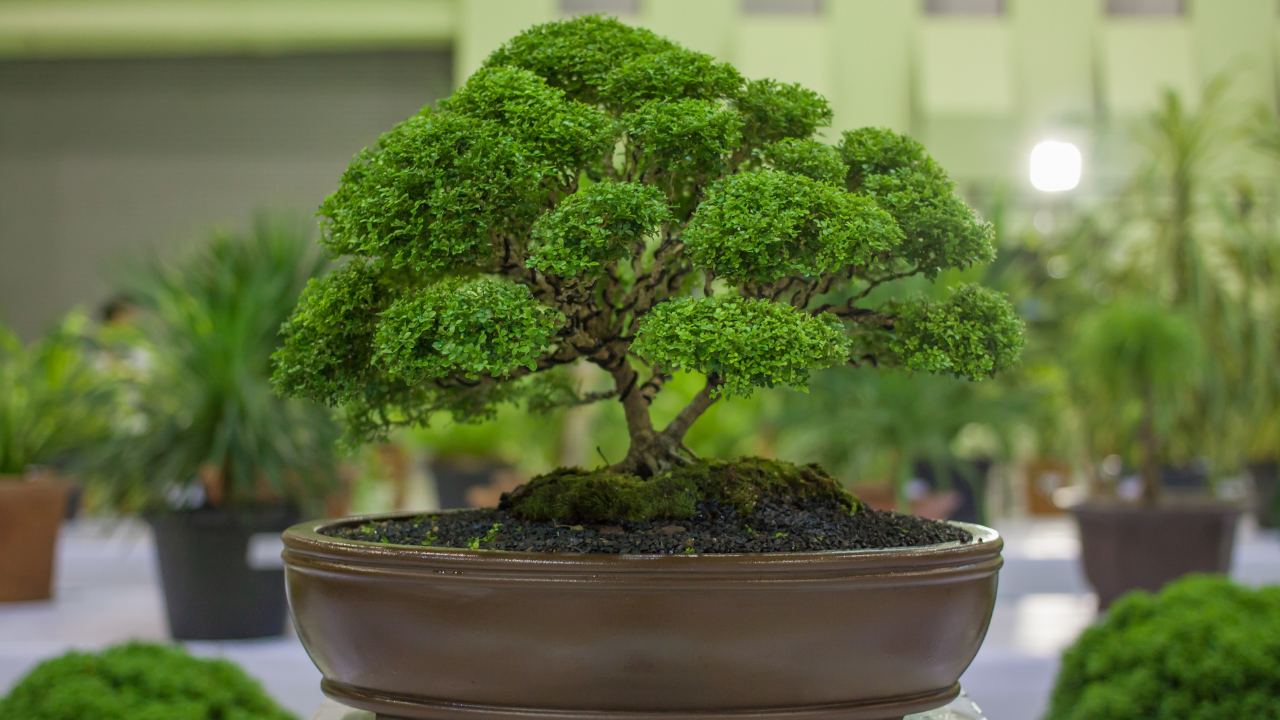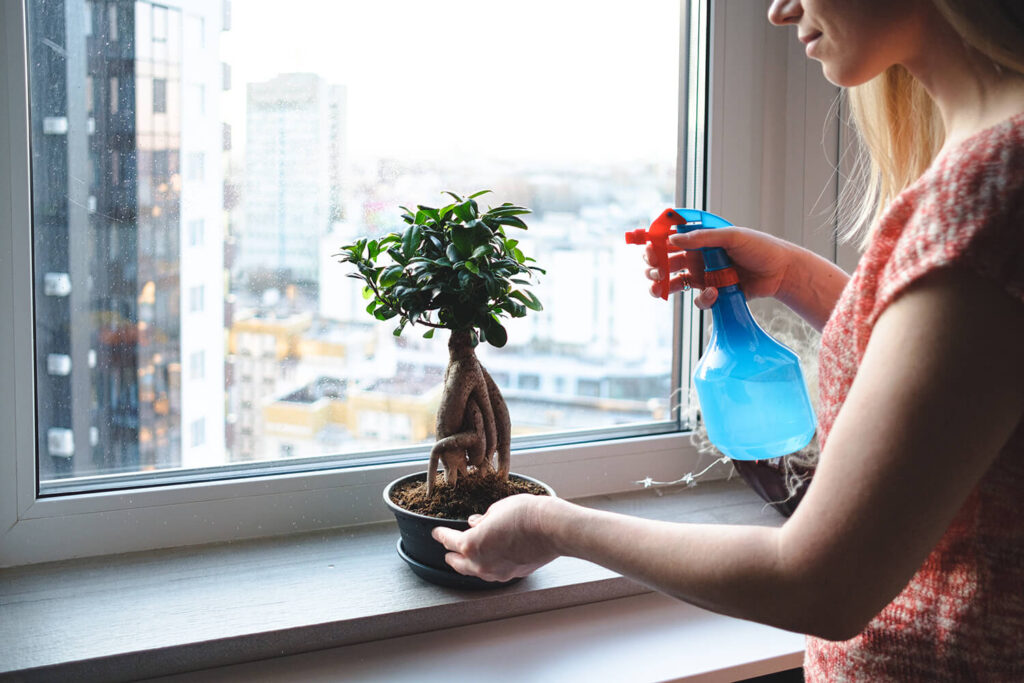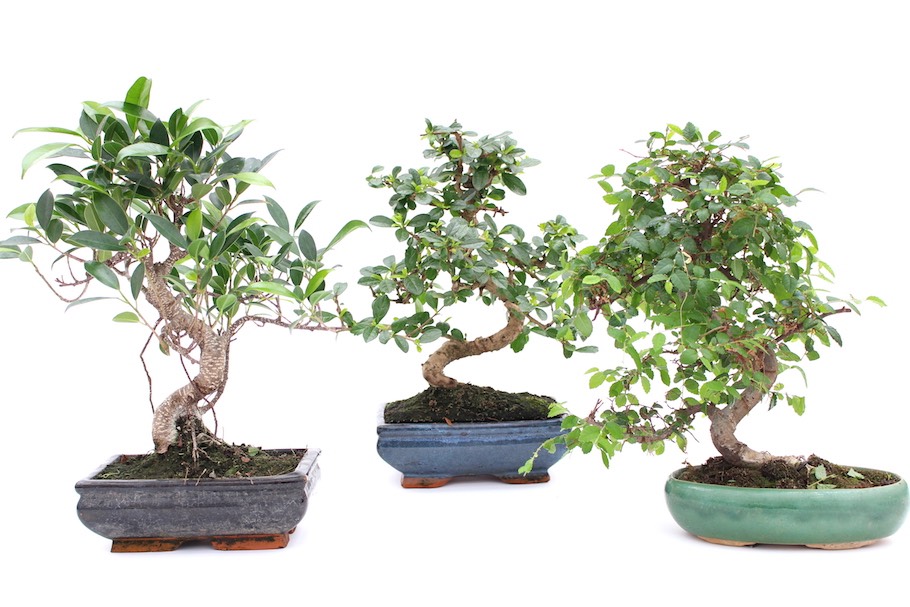Bonsai trees can be grown indoors or outdoors, depending on the species. Indoor bonsai trees require specific care and conditions.
Bonsai trees are miniature versions of full-sized trees. They are cultivated in pots to create a visually appealing, natural aesthetic. Indoor bonsai trees, such as Ficus and Jade, thrive in controlled environments. These trees need proper light, humidity, and watering to remain healthy.
Position your bonsai near a window that receives indirect sunlight. Regular pruning and fertilizing are crucial for maintaining their shape and vigor. Bonsai trees not only beautify your space but also provide a calming influence. With careful attention, indoor bonsai trees can flourish and bring a touch of nature into your home.

Credit: homegrown-garden.com
Bonsai Trees Indoors
Bonsai trees are perfect for indoor spaces. They add beauty and peace. Growing them indoors is fun and rewarding. You can enjoy their charm daily.
Types Of Indoor Bonsai
Some bonsai trees thrive indoors better than others. Here are some popular choices:
- Ficus Bonsai – Easy to grow and very hardy.
- Chinese Elm – Known for its small leaves and beautiful bark.
- Jade Plant – A succulent with thick, glossy leaves.
- Serissa – Also called ‘Tree of a Thousand Stars’ for its white flowers.
- Japanese Maple – Stunning foliage that changes color with seasons.
Choosing The Right Spot
Placing your bonsai in the right spot is crucial. Here are some tips:
- Light – Ensure your bonsai gets enough light. Place it near a window.
- Humidity – Bonsais need humidity. Use a humidity tray or mist regularly.
- Temperature – Keep the tree in a stable temperature. Avoid drafts and heaters.
Check the table below for ideal conditions:
| Condition | Requirement |
|---|---|
| Light | Bright, indirect sunlight |
| Humidity | 50-70% |
| Temperature | 60-75°F (15-24°C) |
Following these tips will help your bonsai thrive indoors.
Light Requirements
Bonsai trees are wonderful indoor plants that need specific light requirements. Understanding these needs helps your bonsai tree thrive. This section will cover both natural and artificial light needs for your bonsai tree.
Natural Light Needs
Bonsai trees love bright, indirect sunlight. Place your tree near a window that gets plenty of light. East or west-facing windows are ideal. Direct sunlight can be too harsh and may scorch the leaves.
Use sheer curtains to filter the light if necessary. Rotate your bonsai tree every few days. This ensures all sides receive equal light exposure.
Artificial Lighting Options
If natural light is insufficient, consider artificial lighting. LED grow lights are a great choice. They provide the full spectrum of light needed for photosynthesis.
- Fluorescent Lights: Affordable and energy-efficient. Suitable for smaller spaces.
- LED Grow Lights: Long-lasting and customizable. Best for larger setups.
- Incandescent Lights: Not recommended. They produce too much heat.
Place the artificial light source 6-12 inches above the bonsai. Aim for 12-16 hours of light per day. Use a timer to automate the lighting schedule.
| Light Type | Advantages | Disadvantages |
|---|---|---|
| Fluorescent | Energy-efficient, affordable | Less intense light |
| LED | Long-lasting, customizable | Higher initial cost |
| Incandescent | Easy to find | Produces too much heat |
Choose the right light for your bonsai tree. This ensures healthy growth and vibrant leaves.
Watering Techniques
Watering techniques are essential for maintaining a healthy indoor bonsai tree. Proper watering keeps the tree vibrant and thriving. Let’s explore the best practices for watering your indoor bonsai tree.
Frequency Of Watering
Bonsai trees have different watering needs. The frequency depends on the tree species, pot size, and climate. Check the soil moisture daily. Insert a finger about an inch into the soil. If it feels dry, it’s time to water.
During summer, indoor bonsai trees might need water daily. In winter, they may need water every few days. Keep an eye on the soil and adjust accordingly.
Watering Methods
Use a gentle watering method to avoid disturbing the soil. Here are some effective methods:
- Top Watering: Pour water slowly over the soil surface. Ensure even distribution and avoid waterlogging.
- Bottom Watering: Place the bonsai pot in a tray with water. Let the soil absorb water through the drainage holes.
- Misting: Mist the leaves using a spray bottle. This helps maintain humidity and keeps leaves clean.
Ensure proper drainage to prevent root rot. Avoid letting the bonsai sit in standing water.
| Watering Method | Best For |
|---|---|
| Top Watering | Even water distribution |
| Bottom Watering | Preventing soil disturbance |
| Misting | Humidity maintenance |

Credit: hookedonbonsai.com
Soil And Fertilization
Bonsai trees need proper soil and fertilization to thrive indoors. Their unique needs set them apart from regular houseplants. Understanding the right soil mix and nutrient requirements is crucial. This ensures your bonsai stays healthy and beautiful.
Best Soil Mixes
The right soil mix is essential for indoor bonsai trees. It helps in water retention and drainage. Here are some of the best soil mixes:
- Akadama: This is a type of clay soil. It provides excellent drainage and aeration. It is often mixed with other soils.
- Pumice: A lightweight volcanic rock. It aids in water retention and aeration. It is usually mixed with akadama.
- Lava Rock: This adds structure and drainage. It helps prevent root rot.
- Organic Compost: Adds nutrients and helps retain moisture. It should be used sparingly to avoid waterlogging.
Nutrient Requirements
Bonsai trees need specific nutrients to grow. Here are the essential nutrients:
- Nitrogen (N): Promotes healthy leaf growth. It is crucial for photosynthesis.
- Phosphorus (P): Supports root development. It helps in flower and fruit production.
- Potassium (K): Enhances overall plant health. It aids in disease resistance.
A balanced bonsai fertilizer contains these nutrients. Use a fertilizer with a 10-10-10 or 20-20-20 ratio. Apply fertilizer every two weeks during the growing season. Reduce fertilization in winter. Over-fertilizing can damage the bonsai tree.
| Soil Component | Purpose | Proportion |
|---|---|---|
| Akadama | Drainage and Aeration | 40% |
| Pumice | Water Retention | 30% |
| Lava Rock | Structure and Drainage | 20% |
| Organic Compost | Nutrients and Moisture Retention | 10% |
Using the right soil mix and understanding nutrient requirements is vital. This keeps your indoor bonsai tree healthy and vibrant.
Temperature And Humidity
Understanding the right temperature and humidity is crucial for indoor bonsai trees. These factors significantly affect their growth and health.
Ideal Temperature Range
Most indoor bonsai trees thrive in a specific temperature range. Typically, the ideal range is between 60°F and 75°F (15°C to 24°C).
- During the day: Maintain temperatures around 70°F (21°C).
- At night: Keep temperatures around 60°F (15°C).
Avoid placing bonsai trees near drafts, heating vents, or air conditioners. These areas can cause temperature fluctuations, stressing the tree.
Managing Humidity Levels
Bonsai trees require a humid environment to flourish. Indoor air, especially during winter, can be dry.
To manage humidity levels, consider these tips:
- Mist the leaves daily using a spray bottle.
- Place a humidity tray filled with water under the bonsai pot.
- Use a room humidifier to maintain consistent humidity.
Here’s a simple table to show ideal humidity levels:
| Humidity Level | Recommended Actions |
|---|---|
| 40% – 50% | Normal indoor levels, mist occasionally. |
| 30% – 40% | Use a humidity tray and mist daily. |
| Below 30% | Use a room humidifier and mist frequently. |
Maintaining the right humidity helps prevent leaf drop and other issues.
Pruning And Shaping
Pruning and shaping are essential practices for maintaining a healthy bonsai tree indoors. These techniques help control the tree’s growth and enhance its beauty. By understanding how to prune and shape your bonsai, you can create a stunning and healthy miniature tree.
Pruning Techniques
Pruning helps manage the growth of your bonsai tree. It involves removing branches, leaves, and roots to maintain the desired shape. Here are some common pruning techniques:
- Maintenance Pruning: Remove dead leaves and branches.
- Structural Pruning: Shape the tree by trimming specific branches.
- Root Pruning: Trim the roots to promote healthy growth.
Shaping Styles
Shaping gives your bonsai tree a unique appearance. Various styles offer different visual effects. Some popular shaping styles include:
| Style | Description |
|---|---|
| Formal Upright | A straight trunk with evenly spaced branches. |
| Informal Upright | A curved trunk with natural-looking branches. |
| Slanting | A trunk that grows at an angle. |
| Cascade | Branches that flow downward like a waterfall. |
By combining these pruning techniques and shaping styles, you can create a beautiful indoor bonsai tree. Always remember to use clean tools and make precise cuts. This ensures your bonsai remains healthy and visually appealing.
Common Pests And Diseases
Bonsai trees are beautiful indoor plants. They require care to stay healthy. One key aspect is managing pests and diseases. Understanding these problems helps keep your bonsai in top shape.
Identifying Pests
Pests can harm bonsai trees. Common pests include:
- Aphids: Tiny insects, usually green or black. They suck sap from leaves.
- Spider Mites: Very small and hard to see. They create webbing on leaves.
- Scale Insects: Appear as small bumps on stems and leaves. They also suck sap.
- Mealybugs: White, cotton-like insects found on leaves and stems.
Treatment Options
Various treatments can address these pests. Here are some effective options:
- Manual Removal: Use a soft brush or cotton swab with alcohol to remove pests.
- Insecticidal Soap: Safe for indoor use. Spray directly on affected areas.
- Neem Oil: Natural and effective. Mix with water and spray on the tree.
- Biological Controls: Introduce beneficial insects like ladybugs to eat pests.
Regular inspection of your bonsai tree helps catch problems early. Act quickly to keep your tree healthy and pest-free.
Common Diseases
Bonsai trees can also suffer from diseases. Common diseases include:
- Root Rot: Caused by overwatering. Roots turn brown and mushy.
- Powdery Mildew: White, powdery spots on leaves. Thrives in humid conditions.
- Leaf Spot: Dark spots on leaves. Often caused by fungal infections.
- Rust: Orange or yellow spots on leaves. Caused by a fungal infection.
Treatment Options
Here’s how to treat common bonsai diseases:
- Root Rot: Improve drainage and reduce watering. Remove affected roots.
- Powdery Mildew: Increase air circulation. Use a fungicidal spray.
- Leaf Spot: Remove affected leaves. Apply a suitable fungicide.
- Rust: Remove infected leaves. Use a fungicidal spray.
Preventing diseases is easier than treating them. Ensure proper care and monitor your bonsai regularly.

Credit: www.bonsaiempire.com
Benefits Of Indoor Bonsai
Indoor bonsai trees are more than just decorations. These small trees bring many benefits to your home. Let’s explore the aesthetic appeal and health benefits of indoor bonsai trees.
Aesthetic Appeal
Indoor bonsai trees are very beautiful. They add a touch of nature to your home. Their small size makes them perfect for any space.
- Unique Shapes: Each bonsai tree has its own unique shape.
- Artistic Display: Bonsai trees are like living art pieces.
- Natural Beauty: They bring the beauty of nature indoors.
Bonsai trees can fit on tables, desks, or shelves. Their presence creates a peaceful atmosphere. You can enjoy the view of a mini tree right in your room.
Health And Well-being
Indoor bonsai trees are good for your health. They help improve indoor air quality. This is because they absorb carbon dioxide and release oxygen.
Here are some health benefits of indoor bonsai trees:
- Stress Relief: Caring for bonsai trees can reduce stress.
- Air Purification: They help clean the air in your home.
- Improved Focus: Looking at nature helps improve concentration.
Bonsai trees can also improve your mood. They add a calming effect to any room. This can help you feel more relaxed and happy.
Conclusion
Bonsai trees can thrive indoors with proper care. They add beauty and tranquility to any space. Ensure they receive adequate light and water. Regular pruning is essential for maintaining their shape. Indoor bonsai trees are a rewarding hobby that enhances your living environment.
Start your bonsai journey today and enjoy its benefits.

